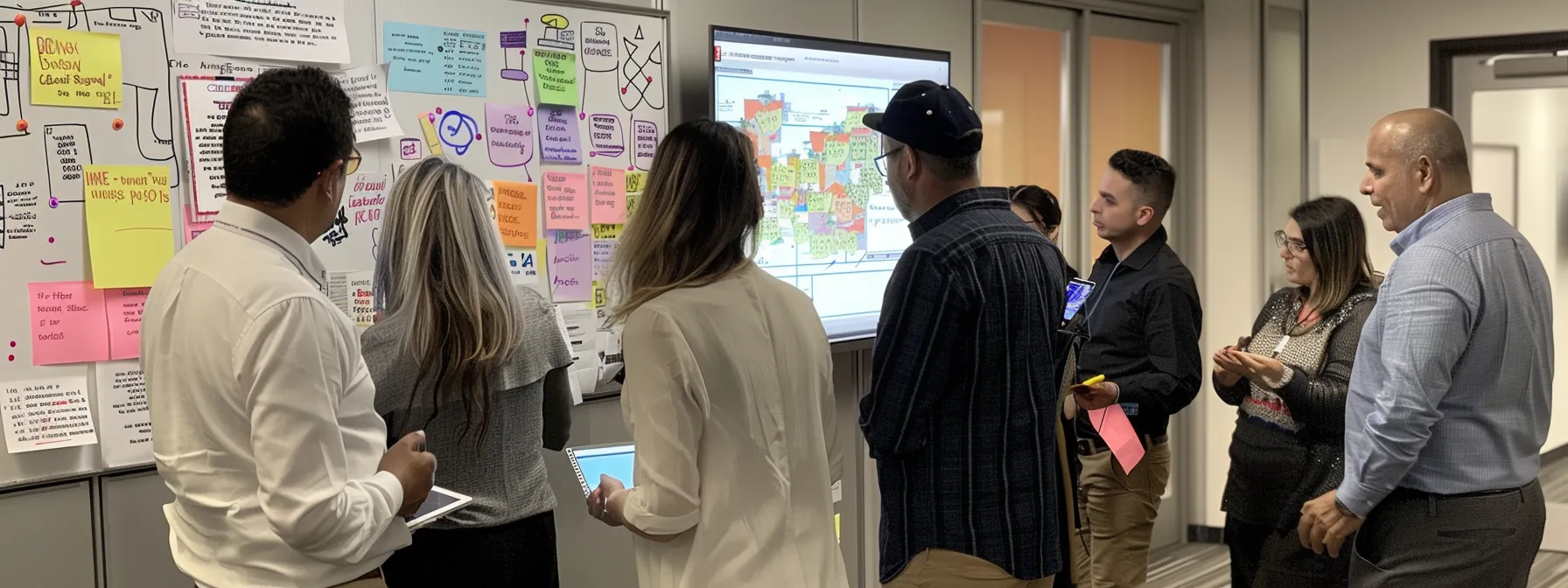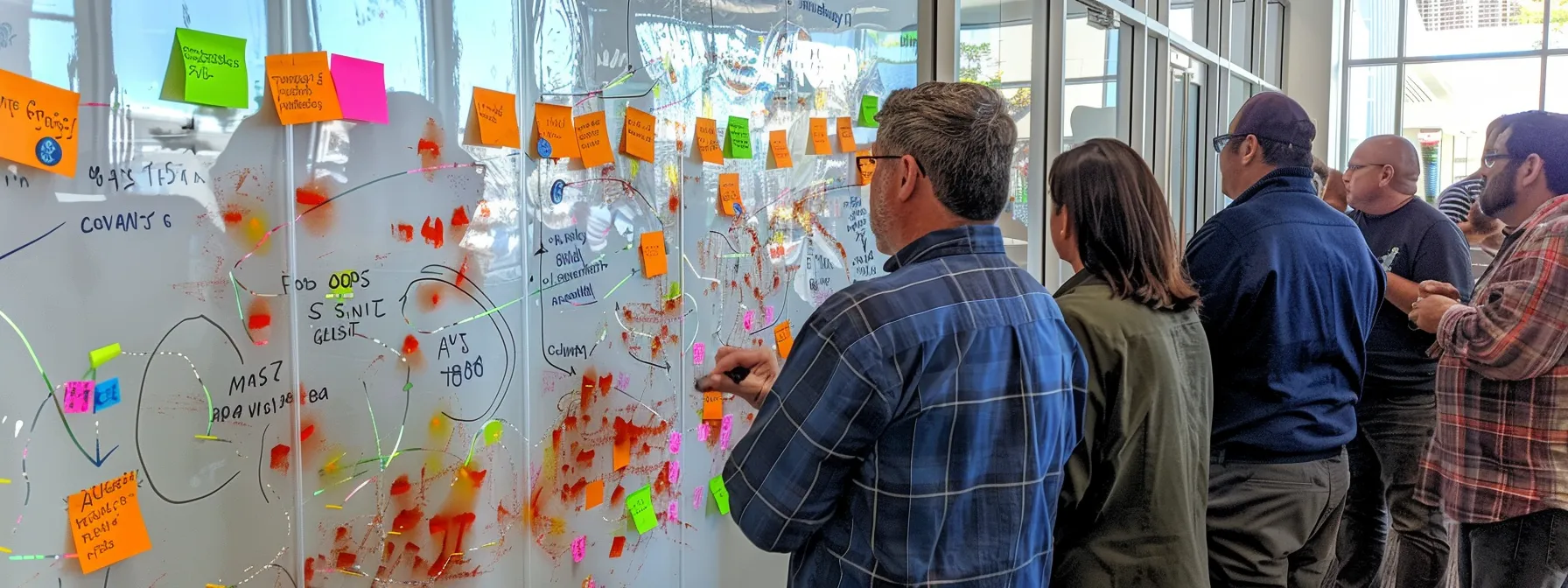PGI
Align Your Goals With Vision: Mastering Techniques for Full Alignment
Many organizations struggle to align their goals with their vision, leading to confusion and inefficiency. This article will explore practical strategies to achieve this alignment, focusing on assessing current goals, effective communication, and overcoming common challenges. By mastering these techniques, readers will learn how to foster collaboration within their teams and enhance their employment practices. With a focus on active listening and stakeholder engagement, this content aims to address the pain points of misalignment, empowering organizations to thrive through clear goal and vision integration.
Key Takeaways
- aligning goals with vision drives organizational success and enhances team performance
- clear communication and open dialogue promote engagement and accountability among team members
- effective training equips employees with skills that support the organizational vision
- regular evaluations of goals ensure continuous alignment with the changing vision
- recognizing contributions reinforces employee motivation and commitment to shared objectives
Understanding the Importance of Aligning Goals With Vision

Vision plays a critical role in driving organizational success, as it provides a clear direction for efforts and initiatives. When goals are misaligned with this vision, they can hinder progress and divert resources away from customer engagement and business growth. Conversely, aligning goals with vision facilitates better team collaboration and individual performance, ultimately serving the target audience more effectively.
The Impact of Vision on Organizational Success
The impact of vision on organizational success is profound, as a well-defined vision guides decision-making and prioritization across all levels. Understanding this connection enables teams to actively engage in brainstorming sessions, ensuring that the goals set during training and onboarding processes reflect the overall vision. By aligning individual and collective objectives with this vision, the workforce becomes motivated, collaborative, and more effective in achieving strategic goals.
How Misaligned Goals Can Hinder Progress
Misaligned goals can significantly hinder progress by creating a disconnect between what a team strives for and the overarching vision of the organization. When teams engage in conversations about goal-setting without conducting a thorough SWOT analysis to ensure strategic alignment, resources may be misallocated, leading to inefficiencies and a diluted company culture. A lack of synchronization not only affects productivity but also dampens morale, as employees may feel their efforts do not contribute to meaningful outcomes.
- Identifying misalignment early improves goal-setting.
- Fostering open conversations encourages engagement.
- Utilizing SWOT analysis sharpens focus on priorities.
- Ensuring strategic alignment enhances resource utilization.
- Promoting a cohesive culture drives collective success.
Benefits of Goal and Vision Alignment for Teams and Individuals
Aligning goals with vision yields numerous benefits for teams and individuals, particularly in enhancing productivity and fostering a sustainable mindset. When individuals understand how their personal objectives contribute to the broader organizational mission, motivation increases, resulting in improved teamwork and efficiency. By implementing effective tips for alignment, teams can navigate the evolving landscape of business demands while ensuring that their efforts are focused on achieving impactful results.
- Increased motivation leads to higher team engagement.
- Enhanced collaboration fosters innovative solutions.
- Clear alignment improves resource allocation.
- Focused objectives drive sustainable growth.
- Achieving aligned goals enhances overall productivity.
Goals must be clear, just like a well-aimed shot. Now, it’s time to look closely at what you seek and how it fits with your vision.
Assessing Your Current Goals and Organizational Vision

Assessing Your Current Goals and Organizational Vision
Organizations must undergo a comprehensive evaluation of their core vision and mission to ensure that existing goals align effectively. This process involves recognizing gaps between current objectives and the organizational vision, allowing teams to set priorities that enhance competitive advantage and drive customer success. Furthermore, understanding these elements supports personal development while mitigating risks associated with misalignment.
By addressing these critical areas, teams can foster an environment that promotes efficiency and clarity, ultimately leading to enhanced performance and sustainable growth.
Identifying Your Core Vision and Mission
Identifying the core vision and mission of an organization is essential for establishing accountability and ensuring alignment with strategic objectives. A well-articulated vision drives employee retention and fosters a culture focused on customer satisfaction and exceptional customer experience. By clearly defining objectives and key results that mirror this vision, teams can create actionable pathways that enhance overall performance and engagement across the organization.
Evaluating Existing Goals for Alignment
Evaluating existing goals for alignment with the organizational vision is a crucial step in optimizing training and development efforts. By systematically reviewing each goal, teams can assess whether they foster innovation, enhance knowledge, or modify behavior towards desired outcomes. Implementing this evaluation not only clarifies skills required for success but also ensures that all objectives resonate with the organization‘s ultimate purpose, enabling a more cohesive approach to achieving shared ambitions:
- Identify key goals that align with the vision.
- Assess the skill sets necessary for goal achievement.
- Evaluate whether goals promote teamwork and innovation.
- Ensure that knowledge gained through training supports overall objectives.
- Adjust misaligned goals to reflect the organizational mission.
Recognizing Gaps Between Goals and Vision
Recognizing gaps between goals and vision is essential for effective goal setting within an organization. By employing analytics, leaders can identify discrepancies that may exist between established objectives and the overarching vision. This process not only promotes transparency but also empowers employees to align their efforts with organizational aspirations, facilitating a more cohesive and engaged workforce.
Setting Priorities Based on Organizational Vision
Setting priorities based on organizational vision is essential for ensuring that customer service excellence translates into increased revenue. When teams adopt a framework that integrates strategic planning with robust project management practices, they can enhance motivation among employees by enabling them to understand how their contributions align with the company’s broader objectives. This alignment fosters a sense of purpose, empowering individuals to focus on tasks that directly impact customer satisfaction and business growth.
Evaluating where you stand is just the beginning. Next, find out how to connect personal ambitions with the larger vision of the organization.
Strategies to Align Individual Goals With Organizational Vision

Incorporating team members into vision planning cultivates creativity and ensures collective input in defining organizational goals. Setting SMART goals aligned with the vision guides focused efforts while aligning personal career objectives with broader business objectives fosters growth. Additionally, utilizing strategic planning tools enhances leadership effectiveness and encourages positive feedback through open dialogue among all stakeholders.
Involving Team Members in Vision Planning
Involving team members in vision planning not only enhances the value of the planning process but also strengthens the organizational culture. By incorporating insights from various stakeholders, organizations ensure that their brand objectives resonate effectively with employees, leading to greater engagement and alignment with the company’s mission. To capture the attention of all team members, leaders can facilitate workshops or brainstorming sessions where individual inputs shape collective goals, fostering ownership and commitment to achieving shared outcomes:
- Encourage diverse participation in vision discussions.
- Utilize workshops to gather insights on brand alignment.
- Promote a sense of ownership among team members.
Setting SMART Goals Aligned With the Vision
Setting SMART goals aligned with the organizational vision enhances employee engagement and job satisfaction by providing a clear framework for success. Employees who understand how their specific objectives contribute to broader organizational strategies are more motivated and engaged. This alignment empowers individuals to take ownership of their roles, resulting in a more cohesive and productive workplace.
Aligning Personal Career Objectives With Organizational Goals
Aligning personal career objectives with organizational goals is essential for fostering both individual and business success. By utilizing methodologies such as “thinking into results,” individuals can structure their career aspirations to harmonize with the company’s overarching vision. This approach enables employees to identify how their roles contribute to broader organizational outcomes, ensuring alignment that enhances motivation and engagement while driving collective growth.
Using Strategic Planning Tools for Alignment
Strategic planning tools play a fundamental role in aligning individual goals with an organization‘s vision. By utilizing frameworks such as SWOT analysis or Balanced Scorecards, teams can visualize how their objectives contribute to overall strategic outcomes. These tools not only promote clarity in goal-setting but also empower employees to track progress, ensuring that their efforts remain focused on achieving the organization’s key objectives and enhancing overall effectiveness.
Aligning individual ambitions with a larger vision is crucial. The next step is to share that vision and those goals in a way that resonates deeply with everyone involved.
Communicating Vision and Goals Effectively

Effectively communicating vision and goals is fundamental for aligning organizational efforts. Techniques for sharing vision with teams ensure everyone understands the direction. Encouraging open dialogue about goals fosters engagement, while using visual aids reinforces alignment. Additionally, keeping vision present in daily operations integrates these principles into the company culture, creating a cohesive and motivated workforce.
Techniques for Sharing Vision With Your Team
Utilizing regular team meetings to share the organizational vision allows leaders to keep their teams focused on common objectives while also fostering a culture of transparency. In these sessions, incorporating visual aids such as charts and infographics can help articulate the vision in relatable terms, making it easier for team members to grasp its impact on daily operations. Encouraging open dialogues where team members can voice their interpretations of the vision not only reinforces understanding but also promotes a sense of ownership and commitment towards achieving aligned goals.
Encouraging Open Dialogue About Goals and Visions
Encouraging open dialogue about goals and visions is essential for fostering a culture of alignment within an organization. By creating safe spaces for team members to share their perspectives, organizations can enhance understanding and commitment to the organizational vision. This approach not only clarifies individual roles in achieving shared goals but also empowers employees to voice potential challenges, ensuring that all insights are valued and considered in the goal-setting process.
Using Visual Aids to Reinforce Alignment
Using visual aids effectively enhances the communication of vision and goals within an organization. Charts, graphs, and infographics can simplify complex information, making it easier for team members to grasp the connections between their individual objectives and the overarching organizational vision. This clarity promotes alignment and encourages engagement, as employees see how their contributions directly impact the company’s success:
- Utilize charts to represent progress towards goals.
- Implement infographics to illustrate the vision clearly.
- Encourage team discussions around visual data to stimulate conversation.
Keeping Vision Present in Daily Operations
Keeping the organizational vision present in daily operations is essential for reinforcing alignment among team members. Regularly integrating the vision into team meetings, internal communications, and performance reviews ensures that everyone remains focused on shared objectives. This consistent visibility cultivates a culture where employees can connect their daily tasks to the broader mission, fostering engagement and driving overall success.
- Integrate vision discussions in team meetings.
- Use internal communications to highlight desired goals.
- Incorporate the vision into performance evaluations.
- Encourage team collaboration that reflects the organizational mission.
- Recognize individual contributions aligned with the vision.
With a clear vision in place, it’s time to ensure that every step taken leads toward that goal. Monitoring progress keeps the focus sharp and the direction steady, paving the way for success.
Monitoring Progress and Maintaining Alignment

Monitoring progress and maintaining alignment with organizational vision is essential for sustained success. This section covers key practices such as setting up regular check-ins and reviews to evaluate goals, adjusting those goals as the vision evolves, recognizing and rewarding alignment efforts, and sharing success stories that reinforce the commitment to the vision. Each of these strategies helps to ensure ongoing connection between individual and organizational objectives.
Setting Up Regular Check-Ins and Reviews
Establishing regular check-ins and reviews is fundamental for ensuring that goals remain aligned with the organizational vision. These sessions provide an opportunity for teams to assess progress, identify obstacles, and recalibrate strategies as needed. By integrating structured feedback mechanisms, organizations can foster an environment of continuous improvement that promotes accountability and enhances alignment with overarching objectives.
Adjusting Goals as Vision Evolves
As organizations evolve, the alignment of goals with the organizational vision must also adapt to maintain relevance and effectiveness. Regularly reviewing and adjusting goals ensures that they resonate with changes in the vision, allowing teams to stay focused on the most impactful objectives. This proactive approach not only enhances strategic alignment but also fosters a culture of agility and responsiveness, enabling organizations to navigate challenges and seize new opportunities successfully.
Recognizing and Rewarding Alignment Efforts
Recognizing and rewarding alignment efforts is essential for fostering a culture that values teamwork and commitment to organizational vision. When employees see their contributions acknowledged, it reinforces the importance of aligning personal goals with the broader mission, thereby enhancing motivation and engagement. Effective programs can include public recognition during team meetings or incentive-based rewards that encourage ongoing alignment, ultimately driving performance and improving overall outcomes.
Sharing Success Stories to Reinforce Alignment
Sharing success stories within an organization serves as a powerful method to reinforce alignment between goals and vision. By showcasing examples of team members who have effectively achieved their objectives in line with the organizational mission, leaders can inspire others to follow suit. These narratives not only highlight the positive impact of aligned efforts but also create a culture of recognition where employees feel valued and encouraged to strive for similar achievements.
Even with careful tracking, challenges lie ahead. Understanding these hurdles can make the journey smoother and keep the vision strong.
Overcoming Common Challenges in Goal and Vision Alignment

Organizations often face challenges in aligning goals with vision, including addressing resistance to change, bridging communication gaps, managing conflicting priorities, and sustaining motivation and commitment. Each of these factors plays a critical role in ensuring that the workforce remains engaged and focused on shared objectives. By exploring practical strategies to navigate these hurdles, teams can enhance alignment and drive success.
Addressing Resistance to Change
Addressing resistance to change is crucial for effective goal and vision alignment within an organization. By actively engaging employees in the change process and providing clear communication regarding the benefits of alignment, organizations can mitigate uncertainties and foster a culture of adaptability. Offering training and opportunities for team members to voice their concerns also plays a vital role in easing transitions, allowing for a smoother implementation of aligned goals.
- Engage employees in the change process.
- Communicate benefits of alignment clearly.
- Provide training to ease transitions.
- Encourage team members to voice concerns.
- Foster a culture of adaptability and support.
Bridging Communication Gaps
Bridging communication gaps is essential for aligning organizational goals with the overarching vision. Clear communication channels allow team members to express their ideas and concerns, ensuring that everyone understands their role in achieving shared objectives. Regular feedback sessions can facilitate this process by providing opportunities for open dialogue, where employees discuss their interpretations of the vision and how their individual goals contribute to collective success.
Managing Conflicting Priorities
Managing conflicting priorities is a critical component in aligning goals with the organizational vision. Teams often face challenges when various objectives compete for attention, leading to confusion and diluted efforts. To address this, organizations can implement structured prioritization processes that help clarify which initiatives align most closely with the overarching vision, ensuring that resources are focused on the most impactful goals.
Sustaining Motivation and Commitment
Sustaining motivation and commitment in the alignment of goals with vision requires ongoing engagement and recognition of progress. Effective strategies include providing continuous feedback and celebrating small victories, which reinforce the connection between individual contributions and the organization‘s overarching mission. By cultivating an environment that emphasizes personal growth alongside corporate objectives, organizations can ensure that employees remain motivated and aligned, ultimately driving collective success.
Conclusion
Aligning goals with the organizational vision is essential for driving success and fostering a motivated workforce. Clear communication, regular assessments, and strategic planning enable organizations to effectively bridge gaps between individual objectives and the overarching mission. By actively involving team members in vision planning and utilizing tools like SMART goals, organizations can enhance collaboration and increase productivity. Ultimately, this alignment not only empowers employees but also propels the organization toward sustainable growth and exceptional customer outcomes.



